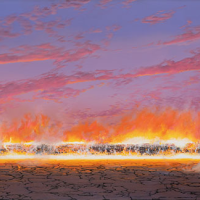43. TIM STORRIER

Throughout his extraordinary career, Tim Storriers most memorable and distinctive motif has unquestionably been that of fire. Fires strength as a symbol is drawn in part from its ability to hold dual, if not contradictory, meanings. As we have seen during the horrific bushfires of last Summer, fire may be an all-powerful force of destruction and devastation, while also presenting the possibility of subsequent regeneration and renewal.
Storrier travelled widely during the first half of his career to France, Italy, England, China, the United States, Turkey, and Egypt, and also made numerous trips to central Australia. As Storrier noted at this time, Ive found that traveling teaches you what is important about yourself what it is that differentiates you from everyone else.1 It was as a result of these trips that fire first emerged in Storriers oeuvre in his celebrated Point to Point series of the 1980s. The Point to Point images enabled Storrier to explore both the space of the subject and the physical space of the surface of the canvas with fire and emptiness providing a correlation with his emotional state. Here, desolation, passion and anger were one.2 The series evolved from a preliminary concept to an experimental outback installation of a burning rope tethered between two poles; it was photographed and documented, and subsequently became a complete body of work. After further synthesis of ideas and reworking, it provided a fertile source of imagery and became the basis for Storriers most important series of works to date.
In Evening Blaze, the horizontally burning rope of the Point to Point series has evolved and made way for a magnificent burning log, raging and smouldering, complete with leaping flames and glowing embers. It would be easy to assume that Evening Blaze is a simple landscape or campfire scene, however as art critic Ashley Crawford argues, such a description belies the more complex psychological content at play in his work [for at] heart, Storriers paintings are far more landscapes of the imagination than the rendering of reality.3 Storrier juxtaposes the fire which is, by nature, transient - with a boundless evening sky. In doing so, Storrier has infused the work with a hint of romanticism; a sense that our time on earth is fleeting when compared with the enduring magnificence of the stars above.
Widely regarded as one of Australias most important living artists, Storriers list of credits is extensive. At the tender age of nineteen, Storrier became the youngest ever recipient of the Sulman Prize for genre painting. In 1994, he was appointed a member of the Order of Australia for services to contemporary Australian art, and in 2012, Storrier won the Archibald Prize with his self-portrait, The Histrionic Wayfarer (after Bosch). In addition to all of Australias major public galleries, Storriers works may be found in the Metropolitan Museum of Art, New York, and numerous private and corporate collections in Japan, Europe and the United States.
Footnotes
1. Opinions are Free, The Australian Magazine, 16 September 2006
2. Hart, D., The Australian Context: Real and Imagined, Tim Storrier: Burning Gifts, Australian Galleries, Sydney, 1989, reproduced on www.storrier.com/essays
3. Ashley Crawford in McGregor, K., William Creek and Beyond, Craftsman House, Sydney, p.283
Marina Brennan BA (Hons)